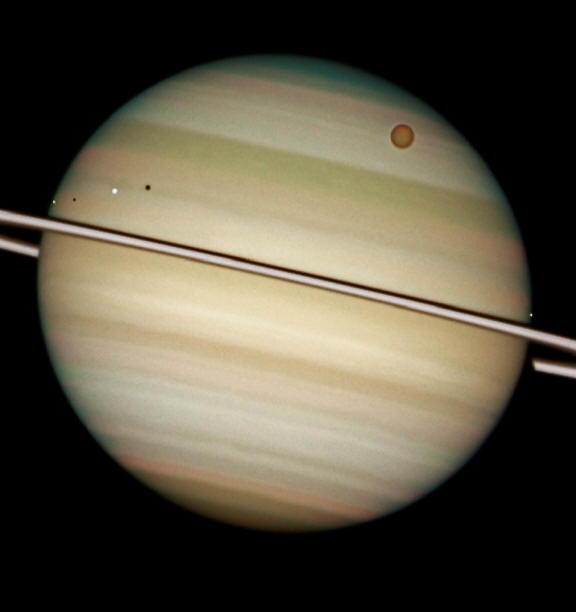|
|
Vanishing Rings
May
20, 2009
Saturn's rings will soon
disappear from view. What force
created and sustains them?
Every fourteen or fifteen years,
Saturn's rings become invisible to
telescopes on Earth. The reason is
that the planet is tilted on its
axis by 27.4 degrees. Since the ring
plane is titled at the same angle,
as Saturn revolves around the Sun in
its 30 year orbit, it gradually
shifts its perspective, bringing the
rings into visual alignment with the
equator.
Saturn's main rings, including gaps,
are approximately 416,000 kilometers
wide, but are estimated to be a mere
50 meters thick, possibly as little
as 10 meters. This means that even
the most powerful Earth-based
telescopes can detect only a thin
wire extending across the planetary
disk when they are edge on.
Modern astronomers postulate that
Saturn's rings were formed in one of
three ways. Some believe that they
are the icy leftovers from the
original nebular cloud out of which
the planet condensed. Others suggest
that the orbit of a small moon
gradually brought it too close to
the giant planet, whereupon it was
torn apart by tidal forces. Still
others believe that the rings were
created when a moon was destroyed by
the impact of an asteroid, leaving
the fragments behind in their own
orbits. Regardless of the way they
were formed, they are theorized to
be over four billion years
old—almost as old as the Solar
System.
What sustains the rings is still a
mystery to astrophysicists. If they
were formed billions of years ago,
then without being fed new material
they would have been drawn down into
Saturn's gravitational maelstrom and
destroyed. It is thought that
micro-meteorite impacts "erode"
material off some small moons and
eject it into orbit, where it is
slowly sorted by Saturn's gravity
field into thousands of individual
bands. The rings continue because
some moons are getting smaller all
the time.
However, the Electric Universe
hypothesis sees things differently.
In
previous Thunderbolts Picture of
the Day articles about the
plasmasphere around Saturn, it was
noted that planets and moons do not
exist in an electrically neutral
environment. Saturn, in particular,
has a
family of moons that exhibit
electric discharge machining on a
vast scale, as well as features
within its atmosphere that could be
characterized as
lightning discharges.
The aurorae on Saturn emit intense
radio waves and the planet is
surrounded by a torus of plasma that
emits x-rays and extreme ultraviolet
light. Saturn seems to display many
aspects that are predicted by the
Electric Universe theory, including
the shape of its rings. In 1913
Kristian Birkeland wrote: "It seems
almost incredible that such a ring
of cosmic dust should be able to
exist for ever, so to speak, without
other governing forces than
gravitation..."
Planets with magnetic fields can
trap hot particles to form giant
electrified clouds. NASA scientists
have noted that Saturn's magnetic
field bends around Enceladus "due to
electric currents generated by the
interaction of atmospheric particles
and the magnetosphere of Saturn."
Further flattening of the plasma
torus on the sunward side
demonstrates an electrical (not
mechanical) effect is occurring
between Saturn and the Sun.
Gravity-only models of the solar
system insist that Saturn's rings
can only be created, held and shaped
by the activity of "shepherd moons"
and angular momentum. Instead, we
should look to the electrical force
that is orders of magnitude more
powerful.
Stephen Smith
|
|
|
|
|
|
SPECIAL NOTE - **New Volumes Available:
We are pleased to announce a new
e-book series
THE UNIVERSE ELECTRIC. Available now, the first volume
of this series, titled Big Bang, summarizes the failure of modern cosmology
and offers a new electrical perspective on the cosmos. At
over 200 pages, and
designed for broadest public appeal, it combines spectacular
full-color graphics with lean and readily understandable
text.
**Then second and third volumes in the series are now available,
respectively titled Sun and Comet, they offer
the reader easy to understand explanations of how and why these bodies
exist within an Electric Universe.
High school and college students--and teachers in
numerous fields--will love these books. So will a large
audience of general readers.
Visitors to the Thunderbolts.info site have often
wondered whether they could fully appreciate the Electric
Universe without further formal education. The answer is
given by these exquisitely designed books. Readers from
virtually all backgrounds and education levels will find them
easy to comprehend, from start to finish.
For the Thunderbolts Project, this series is a milestone.
Please see for yourself by checking out the new
Thunderbolts Project website, our leading edge in
reaching new markets globally.
Please visit our
Forum
|
|
|
|
|
|
|
|







